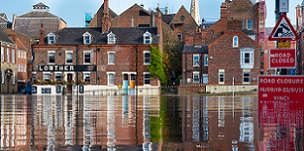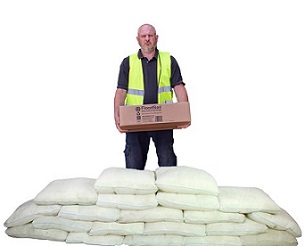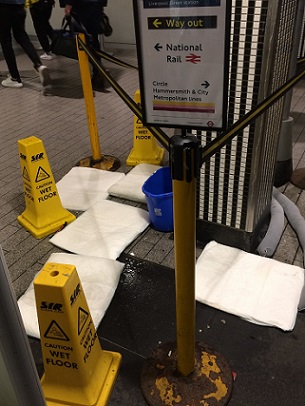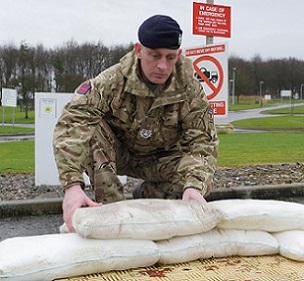 Flooding causes colossal damage within communities, forcing people out of their homes for months and closing businesses. Photo of flooded York taken by Andy Falconer.
Flooding causes colossal damage within communities, forcing people out of their homes for months and closing businesses. Photo of flooded York taken by Andy Falconer.
 Many councils use FloodSax sandless sandbags. All these 20 FloodSax came from this one easy-to-carry box.
Many councils use FloodSax sandless sandbags. All these 20 FloodSax came from this one easy-to-carry box.
 Flash flooding can bring major roads grinding to a halt.
Flash flooding can bring major roads grinding to a halt.
 FloodSax used to soak up flooding in the London Underground
FloodSax used to soak up flooding in the London Underground
 Sometimes flooding can get so bad that the army is brought in to help. Here is a soldier deploying FloodSax alternative sandbags.
Sometimes flooding can get so bad that the army is brought in to help. Here is a soldier deploying FloodSax alternative sandbags.
How the Government could do far more to lessen the risk of flooding in the UK
A hard-hitting report has revealed that the UK is simply not prepared for the ever-increasing risk of flooding due to climate change.
It says one of the main problems is the county’s drainage system which simply can’t cope with the immense power of torrential rainfall that leads to flash flooding.
And the UK also needs to stage a nightmare flooding scenario to see just how it can cope.
The report has been compiled by independent think tank Bright Blue which is endorsed by almost 200 MPs and has looked at the impact of flooding in the UK since 2007 by analysing local, regional and national newspaper reports.
It comes up with a range of ideas to help mitigate flooding the future. One is that the Government should conduct a civil resilience exercise for an extreme rainfall event in a major UK urban area incorporating significant infrastructure failure. Such an exercise could contain several scenarios happening in the same place including serious flooding at more than one underground station, loss of mobile phone coverage, flooded electricity substations, large numbers of vehicles trapped in floodwater, sewer flooding and impassable emergency services key routes.
The research, called In Deep Water? Mapping The Impacts Of Flooding In The UK Since 2007, shows how flooding has a major impact on local communities and businesses along with key public services such as healthcare, education and critical infrastructure such as transport and energy.
The report comes in the wake of the devastating Storm Arwen which caused widespread power blackouts across the UK in November.
Bright Blue says the Government needs to be far more proactive to prevent future flooding.
It states: “As Storm Arwen showed, the UK needs to take more preventative action, rather than simply reactive measures, to help avoid damage to infrastructure and public services from extreme weather events. The UK Government will need to provide local authorities with greater resources to support systemic adaptation and long-term resilience to especially surface water flood risk.”
For instance, many local councils and flood prevention groups now already use FloodSax alternative sandbags (also known as flood_bags or floodsacks) instead of traditional sandbags to protect homes and businesses from flooding as they are space-saving to store and quick and easy to deploy. They are used by some supermarkets to protect their stores and have also been deployed to deal with flooding on the London Underground.
Bright Blue’s analysis shows that since 2007:
- There have been at least 51 flash floods in major urban areas since 2007. This includes at least 10 in London, seven in Birmingham and the West Midlands, at least seven in Merseyside, six in Greater Manchester and six in Edinburgh. There have also been many others in smaller urban areas.
- At least 15 hospitals have experienced flooding causing disruption or imminent risk of disruption to patient services or hospital support services. Major disruptions to healthcare services include patients diverted to other A&E departments; emergency patients moved within the hospital; evacuation of in-patients to other hospitals; a major power outage in part of a hospital and, extensive flood damage to a primary care centre building making it permanently unsafe.
- At least 68 schools have suffered sufficient water entering buildings to disrupt lessons or school transport stuck in floodwater, including 22 with at least significant damage and seven with severe damage. Major disruptions to education include extensive damage resulting in closure and relocation of all or most teaching for several weeks or months, potentially with children spread between other schools or lessons taking place in mobiles for several months and teachers describing repeat flooding as impacting pupils’ education.
- At least nine care homes and four retirement complexes have been flooded, all of which were catering for the elderly. Major disruptions to social care include carers unable to reach elderly people; loss of power, hot water and heating in care homes; evacuations and residents displaced from a care home for several months.
- Flooding damage to at least 31 UK supermarket branches. Major disruptions to shops and other town centre businesses include flooding throughout the building rendering a supermarket out of action for several days or weeks; structurally unsafe buildings with relocation or permanent closure.
- There have been at least two occasions when dam safety has been at risk due to flooding. In 2019, the dam holding back Toddbrook Reservoir in Derbyshire was damaged during heavy rainfall and the nearby town of Whaley Bridge was evacuated. In 2007, 700 people were evacuated from near Ulley Reservoir in South Yorkshire. There have also been at least three instances of water treatment works flooding.
- There has been at least one instance where emergency services were required to help evacuate a London Underground station and at least one instance of an underground station flooding in Glasgow.
Helen Jackson, Associate Fellow at Bright Blue and report author, said: “The disruption caused by Storm Arwen highlights the need to make our infrastructure resilient to extreme weather and be more preventative and less reactive. Many towns and cities in the UK are seeing repeat episodes of flash flooding affecting households, businesses, and transport systems.
“We need to recognise this trend and do much more to ensure our urban drainage and sewer systems can cope with heavy rainfall as the climate changes. This should include limiting the spread of impermeable surfaces in our cities and ensuring basic measures like drain cleaning are not overlooked.
“The recent furore over sewage spills highlighted the importance of adequate drainage and sewerage systems for environmental quality – but this is not just an environmental issue, it is a public safety issue.”
Ryan Shorthouse, Chief Executive of Bright Blue, added: “Flooding is one of the most serious climate-related challenges that this country is facing and will continue to face as the climate changes further in the coming years.
“Reaching net zero emissions is vitally important, but the impact of flooding is already being felt deeply in communities across the UK. The UK Government can and must do much more to better improve the resilience of local communities, businesses, public services, and critical infrastructure to flooding.”
Bright Blue proposes 24 new policies to mitigate flood risk and bolster resilience to its effects, both locally and nationally. These include:
- The Government should understand as far as possible the present and future likelihood of extreme rainfall events along with the potential consequences for public safety and infrastructure failure.
- Government should implement a comprehensive, major public information campaign covering all aspects of flooding with the aim of increasing national resilience. Advice on knowing your flood risk, how to react during a flood event and improve the flood resilience of your property needs to be disseminated at a national level as many people wrongly believe they are not at risk of flooding and people also may have vulnerable relatives who live in high flood risk areas. A public information campaign should acknowledge the scale of the problem and help communicate a practical sense of how we deal with it.
- The Department for Levelling Up, Housing and Communities (LUHC) should more explicitly acknowledge tackling flooding among its ministerial responsibilities and explicitly designate a minister as responsible for coordinating inclusion of flooding considerations within policies across the department.
- Ensure the proposed new developer contributions levy due to replace Section 106 and the Community Infrastructure Levy under the Government’s current planning reforms actively encourages the alleviation of flood risk associated with new developments.
- The Government should affirm that sewerage companies have a responsibility to ensure surface water sewer networks are not overwhelmed by increasingly heavy rainfall events as the climate changes.
- Defra or the Department for Levelling Up, Housing and Communities should investigate the funding and other barriers which local authorities face in improving their drain clearing and maintenance programmes, as well as how many local authorities actively prioritise high risk areas in their drain clearing schedules and encourage any that don’t. Some local authorities explicitly prioritise locations with a history of flooding and greater use of optimised schedules for clearing drains and gullies could help. Key access routes for the emergency services and critical infrastructure operators could also possibly be identified and prioritised as well as obvious low points such as beneath railway bridges.
- Appoint and commission a new official advisory board to develop recommendations on the most immediate and effective steps central government and local authorities could take to alleviate the UK’s growing urban flash flooding problem in existing developed areas.
To read the full report go to http://www.brightblue.org.uk/bright-blue-enable-sunday-trading-laws-to-be-suspended-during-major-flooding-events/